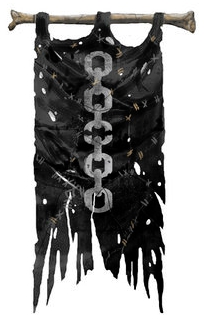Difference between revisions of "Orc Nation"
(Pushed from realm.) |
(Pushed from realm.) |
||
| Line 3: | Line 3: | ||
|header1 = [[File:banner-orc_nation.jpg|120px]] | |header1 = [[File:banner-orc_nation.jpg|120px]] | ||
|label2 = Founded | |label2 = Founded | ||
| − | |data2 = | + | |data2 = 663 SA |
|label3 = Size | |label3 = Size | ||
|data3 = Major Kingdom | |data3 = Major Kingdom | ||
Revision as of 23:08, 13 November 2016
 | |
|---|---|
| Founded | 663 SA |
| Size | Major Kingdom |
| Ruler | U-Gene the Dwarf |
History
The Orc Nation, known in the orcish tongue as Umduc, is the northernmost kingdom in the Reaches. Traditionally, the Orc Nation has been defined by the River White in the south, the Great Sea in the west, the Frozen Sea in the north, and the Shadowyarn Mountains in the east. At different points during the Third Age, orcs have gained access to the Pass of Lar allowing them to spread east over the Shadowyarn Mountains as far east as the Inner Sea. However, the eastern plains, sometimes called the Free Wilderlands, including the Thunderland Plains and Plains of the Beast are very sparsely populated partially because of their extremely severe winters. There is no ruling force in the area, and this region is still mostly untamed.
There have been reports in the Elven Histories of orcs in the northern Reaches as early as the First Age, showing that although the orcs do not keep written records, there have been orcish settlements west of the Shadowyarn Mountains for several thousand years. There are very few orcish buildings surviving from earlier times, as it is the orcish custom to destroy and burn all traces of previous rulers upon their death. Orcish society is built around the concept of the family clan, ruled by a dominant warrior. Oral tradition tells of great orcish leaders of past Ages uniting the clans into great nations. The height of orc power was during the mid-fourth century Third Age when the peoples of the Western Reaches were conquered and a number of major military victories were won (see the Orc Wars).
The current manifestation of the Orc Nation is one of the strongest in several hundred years. In the early ninth century TA, the orc clans united under Gruumsch, He-Who-Watches. An unnatural beast the size of a hill giant with a single eye, Gruumsch has lived for almost five generations of his subjects. Under his leadership, the Orc Nation has subjugated the lesser race of goblins and formed powerful alliances with the ogres, hill giants, and trolls of the Shadowyarn Mountains.
In 833 TA, Gruumsch made a brief pact with the Shadowland Empire. Orc armies played a key role in driving King Gregory and his knights from Teufeldorf. After the collapse of the Council of Seven, Gruumsch's army retreated to the north, although a close tie with Valdemar of Sandal is rumored to exist to this day. During the late ninth century TA, the orcish armies, under the command of their supreme war lord Gruumsch, have made many forays into Reaches both east and west of the Shadowyarn Mountains. These raids continue today.
The Orc Nation does not actively engage in large-scale trade with the outside world, surviving most by hunting and raiding. Rumors of trade with Sandal abound, however, and gold coins minted in that nation are often recovered off the bodies of orcs fallen in battle.
Orcs and goblins live in warrior tribes or warbands. The Orc Nation, united since the early ninth century TA under the command of Gruumsch, is comprised of nine major warbands. These nine are huge with thousands of individuals, while dozens of lesser warbands number little more than a few hundred warriors. These tribes are led by a powerful chieftain called a Warboss or, if he is very powerful, a Warlord. The more successful a Warboss is the more orcs and goblins will flock to join his tribe. As the tribe gets bigger the Warboss leads it to fight bigger battles, so he either becomes more famous still and his tribe gets even bigger or he is killed and his tribe breaks apart.
It is common to find goblins under the sway of orcs. In many cases these subservient goblins are more than happy with their lot, because it gives them a chance to complete any plundering, thieving and despoiling that the orcs forget to do. Every goblin knows that orcs are good fighters, certainly better than goblins, so it is a good life being in an orc tribe even if their masters treat them harshly and eat the odd straggler.
In addition to the common orcs and goblins, Gruumsch has formed powerful alliances with the Large Folk of the Shadowyarn Mountains, the ogres, hill giants and trolls. The elite fighters for the Orc Nation, the Black Orcs, are also subjects to He-Who-Watches, although they typically regard themselves above their common brethren.
Orc Nation (West)
Orc Nation (East)
| |||||||||||||||||||||||||||||||||||||||||||||||||||

